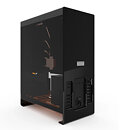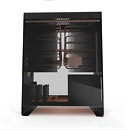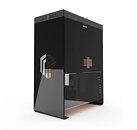- Joined
- Aug 19, 2017
- Messages
- 3,000 (1.07/day)
MonsterLabo, a maker of fanless PC cases, today announced its latest creation - The Beast. Featuring a design made from glass and 6 mm thick aluminium, the ATX case is resembling a design we usually could see only from the folks like InWin. The whole chassis is actually made up of two 3 KG aluminium heatsinks that feature ten 6 mm copper heat pipes each. All of this is used for heat dissipation and the case can accommodate up to 400 W of TDP in passive mode. When two 140 mm fans, running at 500 rpm, are added the case can cool more than 500 W of TDP. The Beast measures at 450 mm (L) x 380 mm (W) x 210 mm (H), making it for one large and heavy case. It supports graphics cards up to 290 mm in PCB length and is fully capable of supporting the latest NVIDIA GeForce RTX 30 series "Ampere" graphics cards. Pre-orders for The Beast are starting on October 9th, with an unknown pricing. You can expect it to be a high premium over 349 EUR price of The First case. Pre-orders will be shipping in Q1 2021.



View at TechPowerUp Main Site



View at TechPowerUp Main Site






